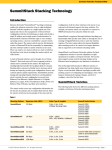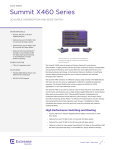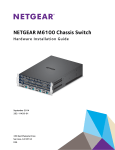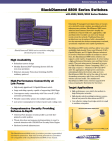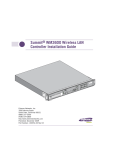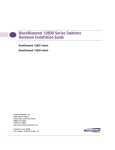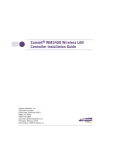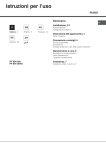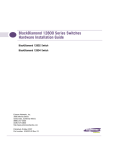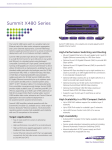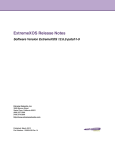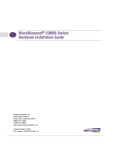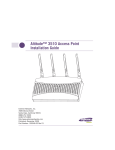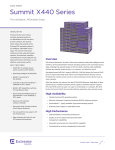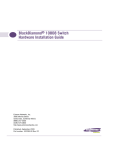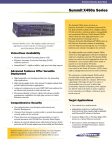Download Extreme Networks® Pluggable Interface Modules Installation Guide
Transcript
Extreme Networks® Pluggable Interface Modules Installation Guide Extreme Networks, Inc. 3585 Monroe Street Santa Clara, California 95051 (888) 257-3000 (408) 579-2800 http://www.extremenetworks.com Published: November 2011 Part Number: 100287-00 Rev. 10 AccessAdapt, Alpine, Altitude, BlackDiamond, Direct Attach, EPICenter, ExtremeWorks Essentials, Ethernet Everywhere, Extreme Enabled, Extreme Ethernet Everywhere, Extreme Networks, Extreme Standby Router Protocol, Extreme Turbodrive, Extreme Velocity, ExtremeWare, ExtremeWorks, ExtremeXOS, Go Purple Extreme Solution, ExtremeXOS ScreenPlay, ReachNXT, Ridgeline, Sentriant, ServiceWatch, Summit, SummitStack, Triumph, Unified Access Architecture, Unified Access RF Manager, UniStack, XNV, the Extreme Networks logo, the Alpine logo, the BlackDiamond logo, the Extreme Turbodrive logo, the Summit logos, and the Powered by ExtremeXOS logo are trademarks or registered trademarks of Extreme Networks, Inc. or its subsidiaries in the United States and/or other countries. sFlow is the property of InMon Corporation. Specifications are subject to change without notice. All other registered trademarks, trademarks, and service marks are property of their respective owners. © 2007 – 2011 Extreme Networks, Inc. All Rights Reserved. For safety compliance information, see Appendix A. Extreme Networks Pluggable Interface Module Installation Guide 2 Contents Preface.........................................................................................................................................................5 Conventions .............................................................................................................................................................6 Related Publications.................................................................................................................................................6 Chapter 1: Extreme Networks SFP and SFP+ Modules .......................................................................... 9 Overview of SFP and SFP+ Modules.......................................................................................................................9 Types of Optical SFP and SFP+ Interfaces............................................................................................................10 SX SFP Module...............................................................................................................................................10 Optical Budget Calculation.......................................................................................................................11 LX SFP Module ...............................................................................................................................................11 Optical Budget Calculation.......................................................................................................................11 ZX SFP Module ...............................................................................................................................................12 Optical Budget Calculation.......................................................................................................................12 1000BASE-BX Bi-Directional SFP Modules....................................................................................................13 100FX SFP Module for Gigabit Ethernet Ports ...............................................................................................13 Dual-speed 100FX/1000LX SFP Module ........................................................................................................14 Optical Budget Calculation.......................................................................................................................14 LX100 SFP Module .........................................................................................................................................15 100BASE-LX10 SFP Module ..........................................................................................................................15 100BASE-BX Bi-Directional SFP Modules......................................................................................................16 100FX SFP Module for Fast Ethernet Ports....................................................................................................16 SR SFP+ Module ............................................................................................................................................16 LR SFP+ Module.............................................................................................................................................17 ER SFP+ Module ............................................................................................................................................17 LRM SFP+ Module..........................................................................................................................................17 10/100/1000BASE-T Copper SFP Module .............................................................................................................18 Preparing to Install or Replace an SFP Module .....................................................................................................18 Installing an SFP Module .......................................................................................................................................18 Connecting Fiber Cables ........................................................................................................................................20 100FX/1000LX SFP Module ...........................................................................................................................20 LX100 SFP Module .........................................................................................................................................21 Removing an SFP Module .....................................................................................................................................21 Chapter 2: QSFP+ Modules ..................................................................................................................... 23 Overview ................................................................................................................................................................23 SR4 QSFP+ Module...............................................................................................................................................24 Installing a QSFP+ Module.....................................................................................................................................24 Removing a QSFP+ Module...................................................................................................................................26 Chapter 3: Direct-Attach Cables ............................................................................................................. 27 Types of Direct-Attach Cables................................................................................................................................27 SFP+ Direct-Attach Passive Cable.........................................................................................................................28 Connecting an SFP+ Direct-Attach Cable.......................................................................................................29 Disconnecting an SFP+ Direct-Attach Cable ..................................................................................................30 QSFP+ Direct-Attach Cables..................................................................................................................................31 Connecting a QSFP+ Direct-Attach Cable ......................................................................................................32 Disconnecting a QSFP+ Direct-Attach Cable..................................................................................................33 Extreme Networks Pluggable Interface Module Installation Guide 3 Chapter 4: Extreme Networks XFP Modules.......................................................................................... 35 Overview of XFP Modules ......................................................................................................................................35 Installing an XFP Module .......................................................................................................................................36 Removing an XFP Module .....................................................................................................................................38 Chapter 5: Extreme Networks XENPAK Transceivers .......................................................................... 41 Overview of XENPAK Modules ..............................................................................................................................41 SR XENPAK....................................................................................................................................................42 LR XENPAK ....................................................................................................................................................42 ER XENPAK....................................................................................................................................................43 ZR XENPAK ....................................................................................................................................................43 LW XENPAK ...................................................................................................................................................44 Transmitter Clock Locking Mode .............................................................................................................44 LX4 XENPAK ..................................................................................................................................................45 Installing and Removing a XENPAK Module..........................................................................................................45 Installing a XENPAK Module...........................................................................................................................46 Removing a XENPAK Module.........................................................................................................................47 Appendix A: Safety Information.............................................................................................................. 49 Fiber Optic Ports—Optical Safety...........................................................................................................................49 GBIC, SFP (Mini-GBIC), SFP+, QSFP+, XENPAK, and XFP Regulatory Compliance..........................................50 Using Third-Party Optical Modules.........................................................................................................................50 Appendix B: Technical Specifications ................................................................................................... 53 SFP Specifications .................................................................................................................................................53 SFP+ Specifications ...............................................................................................................................................59 QSFP+ Specifications ............................................................................................................................................61 XFP Specifications .................................................................................................................................................62 XENPAK Specifications..........................................................................................................................................66 Pluggable Interface Module Regulatory Compliance .............................................................................................69 SFP+ and QSFP+ Direct-Attach Cable Regulatory Compliance ............................................................................69 Index .......................................................................................................................................................... 71 Extreme Networks Pluggable Interface Module Installation Guide 4 Preface This guide provides information about installing pluggable interface modules in the following Extreme Networks® switches: ● BlackDiamond® 8800 series switches ● BlackDiamond 10808 switch ● BlackDiamond 12800 series switches ● BlackDiamond 20800 series switches ● Summit® family switches: - Summit X150 series switches - Summit X250e series switches - Summit X350 series switches - Summit X450 series switches - Summit X450a series switches - Summit X450e series switches - Summit X460 series switches - Summit X480 series switches - Summit x650 series switches - Summit X670 series switches NOTE The term Summit family switches is used to refer to the group of all the different Summit switch series. The types of pluggable interface modules used in Extreme Networks switches include small form factor pluggable (SFP, SFP+, and QSFP+) modules, XFP transceivers, and XENPAK modules. This guide is intended for use by network administrators responsible for installing and setting up network equipment. It assumes a basic working knowledge of: ● Local area networks (LANs) ● Ethernet concepts ● Ethernet switching and bridging concepts ● Routing concepts ● Simple Network Management Protocol (SNMP) ● Basic equipment installation procedures See the ExtremeXOS Concepts Guide and the ExtremeXOS Command Reference Guide for information about installing and configuring the Extreme Networks switches mentioned in this guide. See the hardware installation guides listed under “Related Publications” on page 6 for information about installing the BlackDiamond and Summit switches mentioned in this guide. Extreme Networks Pluggable Interface Module Installation Guide 5 Preface The information in this guide about compatible switches and components is current as of the date this guide was published. Support for specific cable and optical module types may have been added to other switches or components besides those listed in this guide. For current information about hardware support and the minimum required software for specific devices, refer to the hardware and software compatibility matrix at: http://www.extremenetworks.com/go/hw_sw_matrix Conventions Table 1 and Table 2 list conventions used in Extreme Networks publications. Table 1: Notice Icons Icon Notice Type Alerts you to . . . Note Important features or instructions. Caution Risk of personal injury, system damage, or loss of data. Warning Risk of severe personal injury. Table 2: Text Conventions Convention Description Screen displays This typeface represents information as it appears on the screen, or command syntax. Words in italicized type Italics emphasize a point of information or denote new terms at the place where they are defined in the text. Book titles are printed in italics. Related Publications The Extreme Networks ExtremeXOS® switch documentation set includes: ● ExtremeXOS Concepts Guide ● ExtremeXOS Command Reference Guide ● ExtremeXOS Release Notes ● Extreme Networks BlackDiamond 8800 Series Switches Hardware Installation Guide ● Extreme Networks BlackDiamond 12800 Series Switches Hardware Installation Guide ● Extreme Networks BlackDiamond 10808 Switch Hardware Installation Guide ● Extreme Networks BlackDiamond 20800 Series Switches Hardware Installation Guide ● Extreme Networks Summit Family Switches Hardware Installation Guide ● Extreme Networks Pluggable Interface Modules Installation Guide (this guide) Extreme Networks Pluggable Interface Module Installation Guide 6 Related Publications Hardware and software documentation for Extreme Networks products is available from the Extreme Networks web site at the following location: http://www.extremenetworks.com/go/documentation You can download software concepts guides and reference guides, hardware installation guides, and other documents. Under your product warranty or with a current support contract, you can access software release notes from the eSupport web pages at: https://esupport.extremenetworks.com/ NOTE You must have an active support agreement or a product registered to you in order to receive an eSupport login and access to Extreme Networks software release notes. To request an eSupport user name and password, select the Request Web Login link on the eSupport home page at: https://esupport.extremenetworks.com You can see complete information about all of our services online at: http://www.extremenetworks.com/solutions/service-solutions.aspx For a services proposal in EMEA, contact your Extreme Networks supplier or Extreme Networks sales representative. In the Americas, Japan, and the Asia-Pacific, send an email to [email protected]. A service representative will respond to you within one business day. Extreme Networks Pluggable Interface Module Installation Guide 7 Preface Extreme Networks Pluggable Interface Module Installation Guide 8 1 Extreme Networks SFP and SFP+ Modules CHAPTER This chapter includes the following sections: ● Overview of SFP and SFP+ Modules on page 9 ● Types of Optical SFP and SFP+ Interfaces on page 10 ● 10/100/1000BASE-T Copper SFP Module on page 18 ● Preparing to Install or Replace an SFP Module on page 18 ● Installing an SFP Module on page 18 ● Connecting Fiber Cables on page 20 ● Removing an SFP Module on page 21 Overview of SFP and SFP+ Modules Extreme Networks switches support small form factor pluggable (SFP) interface modules, also known as mini-GBICs. Extreme Networks switches support both optical and copper SFP and SFP+ modules. The types of switches and the I/O modules determine the compatible type of SFP or SFP+ module. Use only Extreme Networks-certified SFP and SFP+ modules, available from Extreme Networks, in the SFP port on the switch or I/O module. Extreme Networks Pluggable Interface Module Installation Guide 9 Extreme Networks SFP and SFP+ Modules Types of Optical SFP and SFP+ Interfaces Extreme Networks switches support the following types of optical SFP and SFP+ interfaces: ● SX SFP module (see page 10) ● LX SFP module (see page 11) ● ZX SFP module (see page 12) ● 1000BASE-BX bidirectional SFP modules (see page 13) - 1000BASE-BX-D - 1000BASE-BX-U ● 100FX SFP module for Gigabit Ethernet ports (see page 13) ● Dual-speed 100FX/1000LX SFP module (see page 14) ● LX100 SFP module (see page 15) ● 100BASE-LX10 SFP module (see page 15) ● 100BASE-BX bidirectional SFP modules (see page 16) - 100BASE-BX-D - 100BASE-BX-U ● 100FX SFP module for 100-Mbps Ethernet (fast Ethernet) ports (see page 16) ● SR SFP+ (see page 16) ● LR SFP+ (see page 17) ● ER SFP+ (see page 17) ● LRM SFP+ (see page 17) The information in this guide about hardware platform support for each type of SFPs is current as of the date this guide was published. Support for specific SFP types may have been added to other switches or I/O modules besides those listed in this guide. For current information about hardware support and the minimum required software for SFPs, refer to the most recent version of the ExtremeXOS release notes. Technical specifications for all SFP modules are listed in Appendix B. SX SFP Module The SX SFP module provides a 1000BASE-X optical connection using LC connectors and multimode fiber cable up to 550 meters long. The SX SFP module conforms to the 1000BASE-SX standard. SX SFP modules are supported in the following Extreme Networks switches: ● BlackDiamond 10808 ● BlackDiamond 8800 series ● BlackDiamond 12800 series ● BlackDiamond 20800 series ● Summit X150 series ● Summit X250e series ● Summit X450 series ● Summit X450a series Extreme Networks Pluggable Interface Module Installation Guide 10 Types of Optical SFP and SFP+ Interfaces ● Summit X450e series ● Summit X460 series ● Summit X480 series ● Summit X650-24x switch: ports 1 through 22, VIM1 module ports ● Summit X670 series ● Summit WM3000 series controllers Optical Budget Calculation When you plan an installation using the SX SFP module, Extreme Networks recommends that 3 dB of the total budget be reserved for losses induced by cable splices or connectors and operating margin. There is no minimum attenuation or minimum cable length restriction. For technical specifications for the SX SFP, see Appendix B. LX SFP Module The LX SFP module provides a 1000BASE-X optical connection using LC connectors and single-mode fiber (SMF) cable up to 10 km long. The LX SFP module conforms to the 1000BASE-LX standard. LX SFP modules are supported on the following Extreme Networks switches: ● BlackDiamond 10808 ● BlackDiamond 8800 series ● BlackDiamond 12800 series ● BlackDiamond 20800 series ● Summit X150 series ● Summit X250e series ● Summit X450 series ● Summit X450a series ● Summit X450e series ● Summit X460 series ● Summit X480 series ● Summit X650-24x switch: ports 1 through 22, VIM1 module ports ● Summit X670 series Optical Budget Calculation Measure cable plant losses with a 1310 nm light source and verify this to be within budget. When you calculate the maximum distance attainable using optical cable with a specified loss per kilometer (for example 0.25 dB/km), Extreme Networks recommends that 3 dB of the total budget be reserved for losses induced by cable splices or connectors, and operating margin. There is no minimum system budget or minimum cable length restriction because the maximum receive power is the same as the maximum transmit power. There is no minimum attenuation or minimum cable length restriction. For technical specifications for the LX SFP, see Appendix B. Extreme Networks Pluggable Interface Module Installation Guide 11 Extreme Networks SFP and SFP+ Modules ZX SFP Module The ZX SFP module is a long-haul SFP that provides a 1000BASE-X optical connection using LC connectors and SMF cable up to 80 km long. ZX SFP modules are supported on the following Extreme Networks switches: ● BlackDiamond 10808 ● BlackDiamond 8800 series ● BlackDiamond 12800 series ● BlackDiamond 20800 series ● Summit X150 series ● Summit X250e series ● Summit X450 series ● Summit X450a series ● Summit X450e series ● Summit X460 series ● Summit X480 series ● Summit X650-24x switch: ports 1 through 22, VIM1 module ports ● Summit X670 series Optical Budget Calculation Measure cable plant losses with a 1550 nm light source and verify this to be within budget. When you calculate the maximum distance attainable using optical cable with a specified loss per kilometer (for example, 0.25 dB/km), Extreme Networks recommends that you reserve 3 dB of the total budget for losses induced by cable splices or connectors and operating margin. A minimum system budget or attenuation is required to prevent saturation of the receiver. For technical specifications for the ZX SFP, see Appendix B. Extreme Networks Pluggable Interface Module Installation Guide 12 Types of Optical SFP and SFP+ Interfaces 1000BASE-BX Bi-Directional SFP Modules The 1000BASE-BX SFP modules include the 1000BASE-BX-U SFP module and the 1000BASE-BX-D SFP module. These two SFP modules are used together to permit a bidirectional Gigabit Ethernet connection using a single strand of SMF cable and LC connectors. The 1000BASE-BX-D SFP operates at wavelengths of 1490 nm TX/1310 nm RX, and the 1000BASE-BX-U SFP operates at wavelengths of 1310 nm TX/1490 nm RX. The 1000BASE-BX-U SFP module is always connected to the 1000BASE-BX-D SFP module. The maximum transmission distance for this connection is 10 km. The 1000BASE-BX SFP modules conform to the IEEE 802.3ah 1000BASE-BX10 standard. The 1000BASE-BX SFP modules are supported on the following Extreme Networks switches: ● BlackDiamond 10808 ● BlackDiamond 8800 series ● BlackDiamond 12800 series ● BlackDiamond 20800 series ● Summit X150 series ● Summit X250e series ● Summit X450 series ● Summit X450a series ● Summit X450e series ● Summit X460 series ● Summit X480 series ● Summit X650-24x switch: ports 1 through 22, VIM1 module ports For technical specifications for the 1000BASE-BX SFP, see Appendix B. 100FX SFP Module for Gigabit Ethernet Ports The 100FX SFP module for Gigabit Ethernet (GE) ports (Model # 10063) provides optical links up to 2 km long using multimode fiber cable. The 100FX SFP for GE ports conforms to the 100FX-MMF standard. The 100FX SFP modules are supported in the following Extreme Networks switches: ● BlackDiamond 8800 series - G24x I/O module - MSM-G8x module - G48Xa I/O module ● BlackDiamond 20800 series ● Summit X450-24x switch: ports 5 through 24 (not supported on combination ports) ● Summit X450a-24x, X450a-24xDC switches: ports 1 through 20 (not supported on combination ports) For technical specifications for the 100FX SFP for Gigabit Ethernet ports, see Appendix B. Extreme Networks Pluggable Interface Module Installation Guide 13 Extreme Networks SFP and SFP+ Modules Dual-speed 100FX/1000LX SFP Module The dual-speed 100FX/1000LX SFP module operates at either 100 Mbps or 1000 Mbps over SMF links up to 10 km long. Operating at 100 Mbps, the dual-speed SFP conforms to the 100BASE-LX standard. Operating at 1000 Mbps, the dual-speed SFP conforms to the 1000BASE-LX standard. The dual-speed 100FX/1000FX SFP modules are supported in the following Extreme Networks switches: ● BlackDiamond 8800 series ● BlackDiamond 12800 series ● BlackDiamond 20800 series ● Summit X450-24x switch: ports 5 through 24 (not supported on combination ports) ● Summit X450a-24x, X450a-24xDC switches: ports 1 through 20 (not supported on combination ports) Optical Budget Calculation The 100FX/1000LX SFP module complies with the 100FX-SMF standard. To use the 100FX/1000LX SFP module in 100FX-MMF operation, a minimum attenuation of 6 dB is required. After the SFP module is installed, connect a 6-dB attenuator to the transmitter side (Tx) of the SFP module. Next, connect the attenuator to the single-mode end of a mode conditioning patch cord. The mode conditioning patch cord transitions the SFP module from SMF to MMF operation. When in SMF operation, 100FX-SMF or 1000LX, measure cable plant losses with a 1310 nm light source and verify this to be within budget. When you calculate the maximum distance attainable using optical cable with a specified loss per kilometer (for example 0.25 dB/km), Extreme Networks recommends that 3 dB of the total budget be reserved for losses induced by cable splices or connectors and operating margin. NOTE The 100FX/1000LX SFP module detects link status based only on the presence of light in the receive cable. Therefore, if a single strand is broken, the link partner on the other port will not detect link down. For technical specifications for the 100FX/1000LX SFP, see Appendix B. Extreme Networks Pluggable Interface Module Installation Guide 14 Types of Optical SFP and SFP+ Interfaces LX100 SFP Module The LX100 SFP module provides a 1000BASE-X optical link up to 100 km long using LC connectors and SMF cable. The LX-100 SFP modules are supported on the following Extreme Networks switches: ● BlackDiamond 8800 series ● BlackDiamond 10808 ● BlackDiamond 12800 series ● BlackDiamond 20800 series ● Summit X150 series ● Summit X250e series ● Summit X450 series ● Summit X450a series ● Summit X450e series ● Summit X460 series ● Summit X480 series ● Summit X650-24x switch: ports 1 through 22, VIM1 module ports ● Summit X670 series For technical specifications for the LX100 SFP, see Appendix B. 100BASE-LX10 SFP Module The 100BASE-LX10 SFP module provides a 100-Mbps optical connection using LC connectors and SMF cable. The maximum transmission distance for this connection is 10 km. The LX10 SFP module is supported in the following Extreme Networks switches: ● Summit X250e series: all ports ● Summit X150 series: combination ports only ● Summit X460 series ● Summit X480 series For technical specifications for the 100BASE-LX10 SFP, see Appendix B. Extreme Networks Pluggable Interface Module Installation Guide 15 Extreme Networks SFP and SFP+ Modules 100BASE-BX Bi-Directional SFP Modules The 100BASE-BX SFP modules include the 100BASE-BX-U SFP module and the 100BASE-BX-D SFP module. These two SFP modules are used together in a Summit family switch to permit a bidirectional 100-Mbps Ethernet connection using a single strand of SMF cable and LC connectors. The 100BASE-BX-U SFP module is always connected to the 100BASE-BX-D SFP module. The 100BASE-BX-D SFP operates at wavelengths of 1550-nm TX/1310-nm RX wavelength), and the 1000BASE-BX-U SFP operates at wavelengths of 1310 nm TX/1550 nm RX. The maximum transmission distance for this connection is 10 km. The 100BASE-BX SFP modules conform to the IEEE 802.3ah standard. The 100BASE-BX SFP modules are supported in the following Extreme Networks switches: ● Summit X250e series: all ports ● Summit X150 series: combination ports only For technical specifications for the 100BASE-BX bi-directional SFP, see Appendix B. 100FX SFP Module for Fast Ethernet Ports The 100FX SFP module for fast Ethernet (FE) ports (Model # 10067) provides a 100-Mbps optical link using LC connectors and 1310-nm multimode fiber (MMF) cable. The maximum transmission distance for this connection is 2 km. The 100FX SFP module for FE ports is supported in the following Extreme Networks switches: ● Summit X250e series switches: all ports ● Summit X150 series switches: combination ports only For technical specifications for the 100FX SFP module for fast Ethernet ports, see Appendix B. SR SFP+ Module The SR SFP+ module provides a 10-Gbps optical connection using LC connectors and multimode fiber cable up to 300 meters long. The SR SFP+ module conforms to the 10GBASE-SR standard. The SR SFP+ module is supported in the following Extreme Networks switches and modules: ● Summit X650-24x switch ● VIM1-10G8X versatile interface module for the Summit X650 series switches ● XGM2-2sf option card in the Summit X350, X450a, and X450e series switches ● XGM3-2sf option card in the Summit X460 series switches ● Summit X670 series For technical specifications for the SR SFP+, see Appendix B. Extreme Networks Pluggable Interface Module Installation Guide 16 Types of Optical SFP and SFP+ Interfaces LR SFP+ Module The LR SFP+ module provides a 10-Gbps optical connection using LC connectors and single-mode fiber cable up to 10 kilometers long. The LR SFP+ module conforms to the 10GBASE-LR standard. The LR SFP+ module is supported in the following Extreme Networks switches: ● Summit X650-24x switch (ports 1 through 24 on the front panel) ● VIM1-10G8X versatile interface module for the Summit X650 series switches ● XGM2-2sf option card in the Summit X350, X450a, and X450e series switches ● XGM3-2sf option card in the Summit X460 series switches ● Summit X670 series For technical specifications for the LR SFP+, see Appendix B. ER SFP+ Module The ER SFP+ module provides a 10-Gbps optical connection using LC connectors and single-mode fiber cable up to 40 kilometers long. The ER SFP+ module conforms to the 10GBASE-ER standard. The ER SFP + module is supported in the following Extreme Networks switches: ● BlackDiamond 8800 series ● Summit X650-24x switch (ports 1 through 24 on the front panel) ● VIM1-10G8X versatile interface module for the Summit X650 series switches ● XGM2-2sf option card in the Summit X350, X450a, and X450e series switches ● XGM3-2sf option card in the Summit X460 series switches ● Summit X670 series For technical specifications for the ER SFP+, see Appendix B. LRM SFP+ Module The LRM SFP+ module provides a 10-Gbps optical connection using LC connectors and multimode fiber cable up to 220 meters long. The LRM SFP+ module conforms to the 10GBASE-LRM standard. The LRM SFP+ module supports link lengths of 220 meters on legacy multimode fiber (MMF) cable. To ensure that specifications are met over Fiber Distributed Digital Interface (FDDI) grade OM1 and OM2 fibers, the transmitter should be coupled through a mode conditioning patch cord. No mode conditioning patch cord is required for applications over OM3 fiber. The LRM SFP+ is supported in the following Extreme Networks switches: ● BlackDiamond 8800 series ● Summit X650-24x switch (ports 1 through 24 on the front panel) ● VIM1-10G8X versatile interface module for the Summit X650 series switches ● XGM2-2sf option card in the Summit X350, X450a, and X450e series switches ● XGM3-2sf option card in the Summit X460 series switches ● Summit X670V-48x switch For technical specifications for the LRM SFP+, see Appendix B. Extreme Networks Pluggable Interface Module Installation Guide 17 Extreme Networks SFP and SFP+ Modules 10/100/1000BASE-T Copper SFP Module The Extreme Networks 10/100/1000BASE-T copper SFP module is compatible with the Gigabit Ethernet standard and 1000 Base-T standard as specified in the IEEE 802.3ab standard. This SFP module provides a 100-Mbps connection using Category 5 cable. The 10/100/1000BASE-T SFP module is supported in the following Extreme Networks switches: ● BlackDiamond 8800 series ● Summit X450 series (not supported on combination ports) ● Summit X450a series (not supported on combination ports) ● Summit X450e series (not supported on combination ports) ● Summit X650 series ● - Summit X650-24x switch: ports 1 through 22, VIM1 module ports - Summit X650-24t switch: VIM1 module ports Summit X670-48x switch For technical specifications for the 10/100/1000BASE-T copper SFP, see Appendix B. Preparing to Install or Replace an SFP Module Complete the following tasks before inserting the SFP module: 1 Inspect and clean the fiber tips, coupler, and connectors. 2 Prepare and clean an external attenuator, if needed. When handling fiber cables, take the following precautions to prevent damage to the cables: ● Do not stretch the fiber. ● Make sure the bend radius of the fiber is not less than 2 inches (5.08 cm). Extreme Networks recommends the following guidelines when installing or replacing SFP modules on an active network: ● Use the same type of SFP module at each end of the link, except for the 1000BASE-BX and 100BSE-BX bi-directional SFP modules. The bi-directional SFP modules include a D-type and a U-type. You must use one D-type SFP and one U-type SFP together to allow for a single fiber bidirectional connection. ● Connect one end of the link to the Tx port. Without an attenuator, measure the total loss from the Tx port to the other site of the link. The total loss must not exceed the total optical system budget. Installing an SFP Module You can add or remove SFP modules in your switch without powering off the system. Figure 1 and Figure 2 show the types of SFP modules and connectors. Extreme Networks Pluggable Interface Module Installation Guide 18 Installing an SFP Module NOTE The bi-directional SFP modules combine two SFP optical devices that must be used as a pair to establish the bidirectional connection over a single fiber. Module C and Module D in Figure 1 show the pair of SFPs for a bi-directional SFP module. WARNING! Optical SFPs contain Class 1 lasers. Invisible laser radiation can occur when laser connections are unplugged. Do not stare into the beam. This device is compliant with FCC 21 CFR 1040.10 and EN60825-1 A2:2001. Figure 1: Optical SFP Module Types and Connectors Module A Blue handle Module B Purple handle Module C Module D Bi-directional mini-GBIC Bi-directional SFP modules SH_019B Extreme Networks Pluggable Interface Module Installation Guide 19 Extreme Networks SFP and SFP+ Modules Figure 2: Copper SFP Module BD_172 CAUTION To prevent ESD damage to an SFP module, always use an appropriately grounded ESD-preventive wrist strap when installing or removing the module. Handle the module by its sides only. Never touch the card-edge connectors at the insertion end of the module. To insert an SFP module: 1 Holding the SFP module by its sides, insert the SFP module into the port on the switch. 2 Slide the SFP module into the port until you hear it click. If the SFP module has a handle, push up on the handle to secure the SFP module. NOTE Disconnect fiber-optic cable from an optical SFP module before removing the SFP module from the port. Connecting Fiber Cables Before you connect fiber cables to the dual-speed 100FX/1000LX SFP module or the LX100 SFP module, note the following information about these SFP modules. 100FX/1000LX SFP Module The 100FX/1000LX SFP module complies with the 100FX-SMF standard. In order to use the 100FX/1000LX SFP module in 100FX-MMF operation, a minimum attenuation of 6 dB is required. After the SFP module is installed, connect a 6-dB attenuator to the transmitter side (Tx) of the SFP module. Then connect the attenuator to the single-mode end of a mode conditioning patch cord. The mode conditioning patch cord transitions the SFP module from SMF to MMF operation. Extreme Networks Pluggable Interface Module Installation Guide 20 Removing an SFP Module LX100 SFP Module To prevent permanent damage to the LX100 SFP module, always check the optical input power of the receiver before you insert the fiber cable. The maximum optical input power is -9 dBm. If you use an optical loopback for diagnostics, the loopback requires a minimum of 12 dB optical attenuation. The recommended attenuation range is 12 to 20 dB. Removing an SFP Module To remove an SFP module: 1 Disconnect the optical cable from the SFP module. 2 Unlatch the SFP module in one of the following ways: ● On an SFP module similar to Module A in Figure 1, press and hold the black plastic tab at the bottom of the connector. ● On an SFP module similar to Module B, Module C, or Module D in Figure 1, rotate the front handle down. 3 Pull the SFP module out of the port on the switch. Extreme Networks Pluggable Interface Module Installation Guide 21 Extreme Networks SFP and SFP+ Modules Extreme Networks Pluggable Interface Module Installation Guide 22 2 QSFP+ Modules CHAPTER This chapter provides information about quad small form factor pluggable (QSFP+) transceivers or modules, and includes the following sections: ● Overview on page 23 ● SR4 QSFP+ Module on page 24 ● Installing a QSFP+ Module on page 24 ● Removing a QSFP+ Module on page 26 Overview A QSFP+ module (Figure 3) provides four 10-gigabit transmit and receive channels in a single pluggable optical module, for an aggregate bandwidth of 40 Gbps. QSFP+ modules are used in Extreme Networks BlackDiamond and Summit switches. Figure 3: QSFP+ Optical Module 1 PL_001 1 = Release handle You can insert or remove QSFP+ modules without powering down the system. The information in this guide about hardware platform support for QSFP+ modules is current as of the date this guide was published. Support for QSFP+ modules may have been added to other switches or I/O modules besides those listed in this guide. For current information about hardware support and the minimum required software for QSFP+ modules, refer to the most recent version of the ExtremeXOS Release Notes. Extreme Networks Pluggable Interface Module Installation Guide 23 QSFP+ Modules SR4 QSFP+ Module The SR4 QSFP+ R4 module provides a 40-Gbps optical connection using MTP® (MPO) optical connectors. This optical module integrates four data lanes in each direction with 40 Gbps aggregate bandwidth. Each lane can operate at 10.3125 Gbps up to 100 meters using OM3 fiber or up to 150 meters using OM4 fiber. The SR4 QSFP+ module conforms to the 802.3ba D3.2 (40GBASE-SR4) standard. The SR4 QSFP+ module is supported in the following Extreme Networks switches and components: ● SummitStack-V80 stacking module installed in a Summit X460 series switch ● VIM2-SummitStack-V80 module installed in a Summit X480 series switch ● VIM4-40GX module installed in a Summit X670V-48x switch ● BlackDiamond 8900-40G6X-xm I/O module For technical specifications for the QSFP+ module, see Appendix B. Installing a QSFP+ Module You can install or remove QSFP+ modules in your switch without powering off the system. WARNING! QSFP+ modules contain Class 1M lasers. Invisible laser radiation can occur when laser connections are unplugged. Do not stare into the beam. This device is compliant with IEC 60825-1 Amendment 2 and CFR 21 Section 1040. To install a QSFP+ module: 1 Remove the QSFP+ module from its antistatic container and remove the dust covers from the module optical connector. If your module has a protective pad covering the card-edge connector, remove it. Store the antistatic container, dust covers, and card-edge connector protective pad in a clean location from which they can be easily retrieved if you need to uninstall the module. 2 Remove any rubber dust covers from the port where you are installing the QSFP+ module. 3 Holding the QSFP+ module by its sides, insert the QSFP+ module into the port on the switch or module (Figure 4). Extreme Networks Pluggable Interface Module Installation Guide 24 Installing a QSFP+ Module Figure 4: Installing a QSFP+ Module PL_002 Summit family switch BlackDiamond 8800 series switch 4 Slide the QSFP+ module into the port until you hear it click into place (Figure 4 and Figure 5). Push up on the handle to secure the QSFP+ module in the switch. Figure 5: Installed QSFP+ Module PL_004 Summit family switch BlackDiamond 8800 series switch 5 If you are installing only one QSFP+ module, make sure that all unoccupied ports are covered with a rubber dust cover, which is shipped with the Summit option card or BlackDiamond I/O module (Figure 5). Extreme Networks Pluggable Interface Module Installation Guide 25 QSFP+ Modules Removing a QSFP+ Module You can remove a QSFP+ module from your Extreme Networks switch without powering off the system. NOTE Disconnect fiber-optic cable from a QSFP+ module before removing the QSFP+ module from the port. To remove a QSFP+ module: 1 Rotate the handle (bail latch) on the QSFP+ module downward (Figure 6). Figure 6: Removing a QSFP+ Module PL_006 Summit family switch BlackDiamond 8800 series switch 2 Pull the connector out of the port. Extreme Networks Pluggable Interface Module Installation Guide 26 3 Direct-Attach Cables CHAPTER Direct-attach copper and fiber cables provide connections between unpopulated SFP+ and QSFP+ ports. This chapter describes direct-attach cables that are used with Extreme Networks optical modules and includes the following sections: ● Types of Direct-Attach Cables on page 27 ● SFP+ Direct-Attach Passive Cable on page 28 ● QSFP+ Direct-Attach Cables on page 31 Regulatory compliance information for all cables is listed in Appendix B. Types of Direct-Attach Cables Extreme Networks switches support three types of direct-attach cables that connect to SFP+ or QSFP+ modules: ● SFP+ direct-attach passive cable ● QSFP+ direct-attach passive copper cable ● QSFP+ direct-attach active fiber cable The types of switches and the I/O modules determine the compatible type of direct-attach cable. Use only Extreme Networks-certified cables, available from Extreme Networks, to make connections to the SFP+ or QSFP+ port on the switch or I/O module. You can connect or disconnect direct-attach cables without powering down the system. Extreme Networks Pluggable Interface Module Installation Guide 27 Direct-Attach Cables SFP+ Direct-Attach Passive Cable The SFP+ direct-attach passive cable (Figure 7) provides a 10-Gbps copper connection between unpopulated SFP+ ports. The cable is available in lengths from 1 meter to 10 meters and is terminated in connectors that are inserted directly into the SFP+ cages in place of optical SFP+ modules. Figure 7: Types of SFP+ Direct-Attach Cable SH_107 Cable A SH_112 Cable B Table 3 lists the available SFP+ direct-attach cables and their model numbers. Table 3: SFP+ Direct-Attach Cables Model Number Length 10304 1 meter 10305 3 meters 10306 5 meters 10307 10 meters The SFP+ direct-attach cable is compatible with the following Summit switches and components: ● Summit X650-24x switch (front ports) ● VIM1-G8X versatile interface module in a Summit X650 series switch ● XGM2-2sf option card installed in a Summit X350 series, X450a series, or X450e series switch ● Summit X670-48x series switches (front ports) ● XGM3-2sf option card installed in a Summit X460 series switch ● S-10G2Xc card in a BlackDiamond 8000 series MSM Extreme Networks Pluggable Interface Module Installation Guide 28 SFP+ Direct-Attach Passive Cable Connecting an SFP+ Direct-Attach Cable To connect an SFP+ direct-attach cable: 1 Holding the SFP+ connector by its sides, insert the connector into the port on the switch (Figure 8 and Figure 9). Figure 8: Connecting an SFP+ Direct-Attach Cable to a Front-Panel Port SH_113 SH_108 Cable B Cable A Figure 9: Connecting an SFP+ Direct-Attach Cable to an XGM2-2sf Option Card SH_109 Cable A SH_114 Cable B 2 Slide the connector into the port until you hear it click into place. Extreme Networks Pluggable Interface Module Installation Guide 29 Direct-Attach Cables Disconnecting an SFP+ Direct-Attach Cable To remove an SFP+ direct-attach cable: 1 If the cable connector is similar to cable A in Figure 7, push the release latch toward the port on the switch (see Figure 10). Figure 10: Disconnecting an SFP+ Direct-Attach Cable (Cable A) SH_010 If the connector is similar to cable B in Figure 7, pull the tab away from the switch port (Figure 11). Figure 11: Disconnecting an SFP+ Direct-Attach Cable (Cable B) SH_111 2 Pull the connector out of the port. Extreme Networks Pluggable Interface Module Installation Guide 30 QSFP+ Direct-Attach Cables QSFP+ Direct-Attach Cables The QSFP+ direct-attach cables (Table 12) provide a 40-Gbps (4 x 10-Gbps) bidirectional copper or optical connection between unpopulated QSFP+ ports. These cables are available in lengths from 0.5 meter to 100 meters and are terminated in connectors that are inserted directly into the QSFP+ cages in place of optical QSFP+ modules. Figure 12: Types of QSFP+ Direct-Attach Cable SH_221 Passive copper cable SH_222 Active optical cable Table 4 lists the available QSFP+ direct-attach cables and their model numbers. Table 4: QSFP+ Direct-Attach Cables Cable Description QSFP+ passive copper cable QSFP+ active optical cable Model Number Length 10311 0.5 meter 10312 1 meter 10313 3 meters 10315 10 meters 10318 100 meters Extreme Networks Pluggable Interface Module Installation Guide 31 Direct-Attach Cables The QSFP+ direct-attach cable is compatible with the following Extreme Networks switches and components: ● SummitStack-V80 stacking module installed in a Summit X460 series switch ● VIM2-SummitStack-V80 module installed in a Summit X480 series switch ● BlackDiamond 8900-40G6X-xm I/O module ● VIM3-40G4X module installed in a Summit X650 series switch ● VIM4-40G4X module installed in a Summit X670V series switch Connecting a QSFP+ Direct-Attach Cable To connect a QSFP+ direct-attach cable: 1 Holding the QSFP+ connector by its sides, insert the connector into the port on the switch (Figure 13). Figure 13: Connecting a QSFP+ Direct-Attach Cable to a SummitStack-V80 Module Passive copper cable SH_193 Active optical cable SH_195 2 Push the connector into the port until you hear it click into place. Extreme Networks Pluggable Interface Module Installation Guide 32 QSFP+ Direct-Attach Cables Disconnecting a QSFP+ Direct-Attach Cable To remove a QSFP+ direct-attach cable: 1 Hold the connector firmly as you pull the release tab away from the stacking port (Figure 14). Figure 14: Disconnecting a QSFP+ Direct-Attach Cable SH_194 Passive copper cable SH_196 Active optical cable 2 Pull the connector out of the port. Extreme Networks Pluggable Interface Module Installation Guide 33 Direct-Attach Cables Extreme Networks Pluggable Interface Module Installation Guide 34 4 Extreme Networks XFP Modules CHAPTER This chapter includes the following topics: ● Overview of XFP Modules on page 35 ● Installing an XFP Module on page 36 ● Removing an XFP Module on page 38 Overview of XFP Modules XFP modules (Figure 15) are 10-gigabit modules that convert serial electrical signals to external serial optical or electrical signals. They are used in the following Extreme Networks switches: ● Summit X350, X450a, X450e, X460, and X480 series switches ● BlackDiamond 10G4Xa, 10G4Xc, and 10G8Xc I/O modules for the BlackDiamond 8800 series switches ● BlackDiamond GM-40XA, GM-40XB, and HM-2X24GA I/O modules for the BlackDiamond 20800 series switch Figure 15: XFP Module 1 2 SH_022 1 = Card edge connector 2 = Handle Extreme Networks Pluggable Interface Module Installation Guide 35 Extreme Networks XFP Modules XFP modules can be installed or replaced in an Extreme Networks switch or I/O module without powering off the system. All Extreme Networks XFP modules comply with IEEE 802.3ae standards and with the latest XFP multi-source agreement (MSA). Extreme Networks switches and modules support the following types of XFP modules: ● LR XFP module The LR XFP module uses single-mode fiber (SMF) cable for links up to 10 km long. It has an LC duplex connector. ● SR XFP module The SR XFP module uses multimode fiber (MMF) cable for links up to 300 m long. It has an LC duplex connector. ● ER XFP module The ER XFP module uses SMF cable for links up to 40 km long. It has an LC duplex connector. ● ZR XFP modules The ZR XFP module uses SMF cable for links up to 80 km long. It has an LC duplex connector. ● Tunable DWDM XFP modules The tunable DWDM XFP module uses SMF cable for links up to 80 km long. It has an LC duplex connector. For current information about hardware support for XFPs, refer to the most recent version of the ExtremeXOS Release Notes. Technical specifications for XFP modules are listed in Appendix B. Installing an XFP Module This section describes how to install an XFP module. You can install or remove an XFP module in your Extreme Networks switch without powering off the system. WARNING! XFP modules contain Class 1 lasers. Invisible laser radiation can occur when laser connections are unplugged. Do not stare into the beam. This device is compliant with FCC 21 CFR 1040.10 and EN60825-1 A2:2001. CAUTION To prevent ESD damage to the XFP module, always use an appropriately grounded ESD-preventive wrist strap when installing or removing the module. Handle the module by its sides only. Never touch the card-edge connectors at the insertion end of the module. To install an XFP module: 1 Remove the XFP module from its antistatic container and remove the dust covers from the module optical connectors. If your module has a protective pad covering the card-edge connector, remove it. Store the antistatic container, dust covers, and card-edge connector protective pad in a clean location from which they can be easily retrieved if you need to uninstall the module. Extreme Networks Pluggable Interface Module Installation Guide 36 Installing an XFP Module 2 Remove any rubber dust covers from the port where you are installing the XFP module. On a Summit option card, move the handle to an upright position to access the XFP ports (see Figure 16). Figure 16: Accessing the XFP Ports 1 SH_023 1 = XFP ports 3 Make sure that the XFP handle (bail latch) is rotated all the way up (see Figure 17). 4 Holding the module by its sides, partially insert the XFP module into the XFP port (see Figure 17). Figure 17: Installing an XFP Module 10G BAS E-X XFP SH_024 BD_175 Summit family switch BlackDiamond 8800 series switch 5 Slide the XFP module as far as possible into the slot until you hear it click, indicating that it is firmly attached (see Figure 17 and Figure 18). Extreme Networks Pluggable Interface Module Installation Guide 37 Extreme Networks XFP Modules Figure 18: Installed XFP Module 10G BAS E-X XFP SH_025 Summit family switch BlackDiamond 8800 series switch BD_176 6 If you are installing only one XFP module, make sure that all unoccupied ports are covered with rubber dust covers, which are shipped with the option card or I/O module (see Figure 18). NOTE To prevent permanent damage to a ZR XFP or DWDM XFP, always check the optical input power of the receiver before inserting the fiber cable. The maximum optical input power for these XFPs is –7 dBm. If you use an optical loopback for diagnostics, the loopback requires a minimum of 15 dB optical attenuation. The recommended attenuation range is 15 to 20 dB. NOTE To ensure that your XFP module is undamaged upon installation, you can correlate factory test data with your installation site test data by consulting the average power reference values shown on the XFP module test data sheet (Part No. 121080-00) enclosed with the module. Removing an XFP Module You can remove an XFP module from your Extreme Networks switch or I/O module without powering off the system. The XFP module is shown in Figure 15 on page 35. NOTE Disconnect fiber-optic cable from an XFP module before removing the XFP module from the port. Extreme Networks Pluggable Interface Module Installation Guide 38 Removing an XFP Module To remove an XFP module: 1 Rotate the handle (bail latch) on the XFP module downward (Figure 19). 2 Carefully pull the XFP module out of the port. Figure 19: Removing an XFP Module EX_194 3 Place the dust covers back into the XFP module connectors. 4 Place the XFP module immediately into an antistatic container to protect it from ESD damage and dust. Extreme Networks Pluggable Interface Module Installation Guide 39 Extreme Networks XFP Modules Extreme Networks Pluggable Interface Module Installation Guide 40 5 Extreme Networks XENPAK Transceivers CHAPTER This chapter provides information about the XENPAK optical transceiver modules used in Extreme Networks equipment and includes the following sections: ● Overview of XENPAK Modules on page 41 ● Installing and Removing a XENPAK Module on page 45 Overview of XENPAK Modules The BlackDiamond 8800 series switches, BlackDiamond 10808 switch, BlackDiamond 12800 series switches, and Summit family switches support several types of XENPAK transceiver modules. All of these modules conform to the 10 Gigabit Ethernet standard defined by the IEEE 802.3ae as applicable CAUTION XENPAK modules contain Class 1 laser devices. Invisible laser radiation can occur when the connectors are open. Do not stare into the beam. This device is compliant with FCC 21 CFR 1040.10, 1040.11, and EN60825-1 A2:2001. Extreme Networks switches and modules support the following types of XENPAK interfaces: ● SR XENPAK on page 42 ● LR XENPAK on page 42 ● ER XENPAK on page 43 ● ZR XENPAK on page 43 ● LX4 XENPAK on page 45 ● LW XENPAK on page 44 NOTE CX4 XENPAKs are also supported by Extreme Networks devices; contact your vendor to obtain these. Extreme Networks Pluggable Interface Module Installation Guide 41 Extreme Networks XENPAK Transceivers NOTE Use only Extreme Networks-approved XENPAK modules in all Extreme Networks devices. SR XENPAK The SR XENPAK supports multimode fiber (MMF) cable and has SC connectors. The SR XENPAK requires the software versions listed in Table 5. Table 5: SR XENPAK Software Requirements Switch Model Required Software BlackDiamond Switches BlackDiamond 10808 ExtremeXOS 11.1.1 or later BlackDiamond 8800 series ExtremeXOS 11.1.1 or later BlackDiamond 12804 ExtremeXOS 11.4 or later BlackDiamond 12802 ExtremeXOS 12.0 or later Summit Switches Summit X450 series ExtremeXOS 11.2.0 or later Summit X450a series ExtremeXOS 11.2.0 or later Summit X450e series ExtremeXOS 11.2.0 or later For technical specifications for the SR XENPAK, see Appendix B. LR XENPAK The LR XENPAK supports single-mode fiber (SMF) cable and has SC connectors. The LR XENPAK requires the software versions listed in Table 6. . Table 6: LR XENPAK Software Requirements Switch Model Required Software BlackDiamond Switches BlackDiamond 10808 ExtremeXOS 11.1.1 or later BlackDiamond 8800 series ExtremeXOS 11.1.1 or later BlackDiamond 12804 ExtremeXOS 11.4 or later BlackDiamond 12802 ExtremeXOS 12.0 or later Summit Switches Summit X450 series ExtremeXOS 11.2.0 or later Summit X450a series ExtremeXOS 11.2.0 or later Summit X450e series ExtremeXOS 11.2.0 or later For technical specifications for the LR XENPAK, see Appendix B Extreme Networks Pluggable Interface Module Installation Guide 42 Overview of XENPAK Modules ER XENPAK The ER XENPAK supports SMF cable and has SC connectors. The ER XENPAK requires the software versions listed in Table 7. Table 7: ER XENPAK Software Requirements Switch Model Required Software BlackDiamond Switches BlackDiamond 10808 ExtremeXOS 11.1.1 or later BlackDiamond 8800 series ExtremeXOS 11.1.1 or later BlackDiamond 12804 ExtremeXOS 11.4 or later BlackDiamond 12802 ExtremeXOS 12.0 or later Summit Switches Summit X450 series ExtremeXOS 11.2.0 or later Summit X450a series ExtremeXOS 11.2.0 or later Summit X450e series ExtremeXOS 11.2.0 or later For technical specifications for the ER XENPAK, see Appendix B. ZR XENPAK The ZR XENPAK supports SMF cable and has SC connectors. The ZR XENPAK requires the software versions listed in Table 8. Table 8: ZR XENPAK Software Requirements Switch Model Required Software BlackDiamond Switches BlackDiamond 10808 ExtremeXOS 11.3.1 or later BlackDiamond 8800 series ExtremeXOS 11.3.1 or later BlackDiamond 12804 ExtremeXOS 11.4 or later BlackDiamond 12802 ExtremeXOS 12.0 or later Summit Switches Summit X450 series ExtremeXOS 11.3.1 or later Summit X450a series ExtremeXOS 11.3.1 or later Summit X450e series ExtremeXOS 11.3.1 or later For technical specifications for the ZR XENPAK, see Appendix B. WARNING! To prevent permanent damage to the ZR XENPAK and other equipment: always check the optical input power of the receiver before inserting the fiber. The maximum optical input power for the receiver is -7 dBm. If you use optical loopback for diagnostics purposes, the loopback requires a minimum of 15 dB optical attenuation. The recommended attenuation range is 15 dB to 20dB. Extreme Networks Pluggable Interface Module Installation Guide 43 Extreme Networks XENPAK Transceivers LW XENPAK The LW XENPAK module requires the software versions listed in Table 9. Table 9: LW XENPAK Software Requirements Switch Model Required Software Release BlackDiamond Switches BlackDiamond 10808 ExtremeXOS 11.4.1 or later BlackDiamond 12804 ExtremeXOS 11.4.1 or later BlackDiamond 12802 ExtremeXOS 12.0 or later Summit Switches Summit X450a ExtremeXOS 11.5.0 or later Summit X450e ExtremeXOS 11.5.0 or later NOTE BlackDiamond 10808 switches and BlackDiamond 12804 switches running software earlier than ExtremeXOS 11.4.2.3 do not support jumbo-size frame for the LW XENPAK. These switches support only standard-size frame for the LW XENPAK. BlackDiamond 10808 switches and BlackDiamond 12804 switches running the latest version of ExtremeXOS 11.4 support jumbo-size frame for the LW XENPAK with a 5% decrease in performance, allowing for 95% of the maximum WAN PHY traffic. ExtremeXOS 11.5.0 or later supports the LW XENPAK at full functionality with 100% performance in the Summit X450a and X450e series switches. CAUTION The maximum input power (average receive power) should be less than 0.5 dBm. For technical specifications for the LW XENPAK, see Appendix B. Transmitter Clock Locking Mode The LW XENPAK module provides an interface connection between a 10-gigabit Ethernet and a 10-gigabit SONET/SDH network from a 10-gigabit Ethernet equipment port. The default transmitter clock locking mode of the LW XENPAK module is set to line timing mode. When in line timing mode, the LW XENPAK module transmitter clock is locked to the receiver-recovered clock. When the LW XENPAK is connected to the SONET/SDH network on the other side of optical cable, the LW XENPAK transmitter clock synchronizes with the SONET/SDH clock source, which helps reduce the pointer adjustment between the SONET/SDH network and the LW XENPAK. To prevent a clock reference loop, be sure that only one end of a link is using line timing mode and to use internal timing when testing with an optical loopback cable. Extreme Networks Pluggable Interface Module Installation Guide 44 Installing and Removing a XENPAK Module LX4 XENPAK The LX4 XENPAK supports multimode MMF cable in intra-building connections and SMF cable for interbuilding connections. The LX4 XENPAK has SC connectors. The LX4 XENPAK requires the software versions listed in Table 10. Table 10: LX4 XENPAK Software Requirements Switch Model Required Software BlackDiamond Switches BlackDiamond 10808 ExtremeXOS 11.3.1 or later BlackDiamond 8800 series ExtremeXOS 11.3.1 or later BlackDiamond 12804 ExtremeXOS 11.4 or later BlackDiamond 12802 ExtremeXOS 12.0 or later Summit Switches Summit X450 series ExtremeXOS 11.3.1 or later Summit X450a series ExtremeXOS 11.3.1 or later Summit X450e series ExtremeXOS 11.3.1 or later For technical specifications for the LX4 XENPAK, see Appendix B. Installing and Removing a XENPAK Module WARNING! XENPAK modules become very hot after prolonged use. Be careful when removing a XENPAK module from the chassis or option card. If the XENPAK module is too hot to touch, disengage the XENPAK module and allow it to cool before removing it completely. This section describes installing and removing the XENPAK module (Figure 20). You can install or remove the XENPAK module from your Extreme Networks switch without powering off the system. NOTE On a Summit X450 series, X450a series, or X450e series switch, the XENPAK module is inserted into an optional module card. Although the module card is not hot-swappable, you can hot swap the XENPAK into and out of the module card on the Summit. For information about the optional module card for XENPAKs on a Summit X450 series, X450a series, or X450e series switch, see the Summit Family Switches Hardware Installation Guide. Extreme Networks Pluggable Interface Module Installation Guide 45 Extreme Networks XENPAK Transceivers Figure 20: XENPAK Module Card edge connector EWUG003B WARNING! XENPAK modules contain Class 1 lasers. Invisible laser radiation can occur when laser connections are unplugged. Do not stare into the beam. This device is compliant with FCC 21 CFR 1040.10, and EN60825-1 A2:2001. CAUTION To prevent ESD damage to the XENPAK module, always use an appropriately grounded ESD-preventive wrist strap when installing or removing the module. Handle the module by its sides only. Never touch the card-edge connectors at the insertion end of the module. Installing a XENPAK Module To install a XENPAK module: 1 Remove the XENPAK module from its antistatic container and remove the dust covers from the module optical connectors. If your module has a protective pad covering the card-edge connector, remove it. Store the antistatic container, dust covers, and card-edge connector protective pad in a clean location from which they can be easily retrieved if you need to uninstall the module. 2 Remove any dust covers from the port on the module into which you are installing the XENPAK module. 3 Holding the module by its sides, insert the XENPAK module into the slot on the I/O module or Summit option card. 4 Slide the XENPAK module as far back into the slot as possible, until you hear it click, indicating that it is firmly attached. 5 Secure the XENPAK module to the I/O module or option card by turning the two captive screws clockwise until the screws are hand-tight. Extreme Networks Pluggable Interface Module Installation Guide 46 Installing and Removing a XENPAK Module NOTE To ensure that your XENPAK module is undamaged upon installation, you can correlate factory test data with your installation site test data by consulting the average power reference values shown on the XENPAK module test data sheet (Part No. 121074-00) enclosed with your module. Removing a XENPAK Module To remove a XENPAK module: 1 Disconnect the optical cable from the XENPAK module. WARNING! XENPAK modules contain Class 1 lasers. Invisible laser radiation can occur when laser connections are unplugged. Do not stare into the beam. 2 Loosen the two captive screws until they are completely free from the I/O module faceplate or the Summit option card. (The captive screws remain attached to the XENPAK module.) 3 Gripping both captive screws, carefully pull the XENPAK module out of the slot. 4 Place the dust covers back into the XENPAK module connectors. 5 Place the XENPAK module immediately into an antistatic container to protect it from ESD damage and dust. Extreme Networks Pluggable Interface Module Installation Guide 47 Extreme Networks XENPAK Transceivers Extreme Networks Pluggable Interface Module Installation Guide 48 A Safety Information APPENDIX WARNING! Read the following safety information thoroughly before installing Extreme Networks products. Failure to follow this safety information can lead to personal injury or damage to the equipment. Only trained service personnel should perform service to Extreme Networks switches and their components. Trained service personnel have read all related installation manuals, have the technical training and experience necessary to be aware of the hazards to which they are exposed in performing a task, and are aware of measures to minimize the danger to themselves or other persons. Fiber Optic Ports—Optical Safety The following safety warnings apply to all optical devices used in Extreme Networks equipment that are removable or directly installed in an I/O module or chassis system. These devices include, but are not limited to, the following devices: ● SC gigabit interface converters (GBICs) ● SFP optical modules (mini-GBICs) and SFP+ optical modules ● QSFP+ optical modules ● XENPAK transceivers ● XFP laser optic modules CAUTION Laser optic modules become very hot after prolonged use. Take care when removing a laser optic module from the chassis or option card. If the laser optic module is too hot to touch, disengage the laser optic module and allow it to cool before removing it completely. Extreme Networks Pluggable Interface Module Installation Guide 49 Appendix A: Safety Information WARNING! When working with laser optic modules, always take the precautions listed below to prevent exposure to hazardous radiation: ● Never look at the transmit LED/laser through a magnifying device while it is powered on. ● Never look directly at a fiber port on the switch or at the ends of a fiber cable when they are powered on. ● Invisible laser radiation can occur when the connectors are open. Avoid direct eye exposure to the beam when optical connections are unplugged. ● Never alter, modify, or change an optical device in any way other than suggested in this document. GBIC, SFP (Mini-GBIC), SFP+, QSFP+, XENPAK, and XFP Regulatory Compliance ● Class 1 or Class 1M Laser Product ● EN60825-1+A2:2001 or later, European laser standard ● FCC 21 CFR Chapter 1, Subchapter J in accordance with FDA & CDRH requirements ● Application of CE Mark in accordance with the 2004/108/EC EMC Directive, and the 2006/95/EC Low Voltage Directive ● UL and/or CSA registered component for North America ● 47 CFR Part 15, Class A when installed into Extreme products Using Third-Party Optical Modules Extreme Networks optical modules are tested to work in all supported Extreme Networks switches. We recommend that all customers use Extreme Networks optical modules in their Extreme Networks switches. Extreme Networks assumes no liability for third-party optical modules. Although Extreme Networks does not block third-party optical modules, we cannot ensure that all third-party optical modules operate properly in all Extreme Networks switches. The customer assumes all risks associated with using third-party optical modules in Extreme Networks switches. Extreme Networks Pluggable Interface Module Installation Guide 50 Using Third-Party Optical Modules Sicherheitshinweise WARNING! Vor der Installation der Produkte von Extreme Networks sind die nachfolgenden Sicherheitshinweise aufmerksam zu lesen. Die Nichtbeachtung dieser Sicherheitshinweise kann zu Verletzungen oder Schäden an der Ausrüstung führen. Installation, Wartung und Ausbau eines Switch, einer Grundplatte oder einer seiner Komponenten dürfen nur von geschultem und qualifiziertem Servicepersonal durchgeführt werden! Geschulte und qualifizierte Servicetechniker verfügen über die erforderliche technische Ausbildung und Erfahrung, um mögliche Gefahren bei der Durchführung von Servicearbeiten zu erkennen und Maßnahmen zur Minimierung der Gefahr für sich bzw. andere zu treffen. Lichtleiteranschlüsse: Optische Sicherheit WARNING! Beim Umgang mit Lichtleitermodulen sind folgende Vorsichtsmaßnahmen zu beachten: ● Niemals durch ein Vergrößerungsgerät auf die übertragende LED/den Laser schauen, wenn diese(r) eingeschaltet ist. ● Niemals direkt auf einen Lichtleiteranschluss am Switch oder auf die Enden eines Faserkabels schauen, wenn diese eingeschaltet sind. ● Bei offenen Anschlüssen kann es zu unsichtbarer Laserstrahlung kommen. Direkter Augenkontakt mit dem Strahl ist zu vermeiden. ● Ein optisches Gerät niemals auf andere Weise verändern oder modifizieren als in diesem Dokument angegeben. Einhaltung behördlicher Vorschriften durch GBIC, Mini-GBIC, QSFP+, XENPAK und XFP ● Laserprodukt der Klasse 1 oder 1M ● EN60825-1+A2:2001 oder jünger, Europäische Richtlinie für Lasersysteme ● Anwendung der CE-Kennzeichnung gemäß der Richtlinien 89/336/EWG EMV und 73/23/EWG für Niederspannungsgeräte Extreme Networks Pluggable Interface Module Installation Guide 51 Appendix A: Safety Information Extreme Networks Pluggable Interface Module Installation Guide 52 B Technical Specifications APPENDIX This appendix includes the following technical specifications: ● SFP Specifications on page 53 ● SFP+ Specifications on page 59 ● QSFP+ Specifications on page 61 ● XFP Specifications on page 62 ● XENPAK Specifications on page 66 ● Pluggable Interface Module Regulatory Compliance on page 69 SFP Specifications The SX SFP conforms to the 1000BASE-SX standard. Table 11 lists the specifications for the SX SFP interface. Table 11: SX SFP Specifications Parameter Minimum Typical Maximum Transmitter Average launch power -9.5 dBm Center wavelength 830 nm -4 dBm 850 nm 860 nm Receiver Receive sensitivity -17 dBm Average receive power (max) 0 dBm Operating wavelength 770 nm 850 nm 860 nm Link Link power budget 7.5 dB Operating distance 550 m Extreme Networks Pluggable Interface Module Installation Guide 53 Appendix B: Technical Specifications The LX SFP conforms to the 1000BASE-LX standard. Table 12 lists the specifications for the LX SFP interface. Table 12: LX SFP Specifications Parameter Minimum Typical Maximum 1310 nm 1355 nm Transmitter Average launch power -9.5 dBm Center wavelength 1270 nm -3 dBm Receiver Receive sensitivity -19 dBm Average receive power (max) Operating wavelength -3 dBm 1270 nm 1310 nm 1355 nm Link Link power budget 8 dB Operating distance 10 km Table 13 lists the specifications for the ZX SFP interface. Table 13: ZX SFP Specifications Parameter Minimum Typical Maximum Average launch power -2 dBm 0 dBm 3 dBm Center wavelength 1530 nm 1550 nm 1570 nm Transmitter Receiver Receive sensitivity -24 dBm Average receive power (max) -3 dBm Operating wavelength Operating distance 1530 nm 1550 nm 1570 nm 80 km Extreme Networks Pluggable Interface Module Installation Guide 54 SFP Specifications Table 14 lists specifications for the 1000BASE-BX bi-directional SFPs. The 1000BASE-BX SFP modules conform to the IEEE 802.3ah 1000BASE-BX10 standard. Table 14: 1000BASE-BX Bi-directional SFP Specifications Parameter Minimum Typical Maximum Transmitter Average launch power -9 dBm Center wavelength (1000BASE-BX10-D) 1480 nm 1490 nm 1550 nm -3 dBm Center wavelength (1OOOBASE-BX10-U) 1260 nm 1310 nm 1360 nm Receiver Receive sensitivity -19 dBm Average receive power (max) -3 dBm Link Link power budget 8 dB Operating distance 10 km NOTE The 1000BX bidirectional SFPs include two SFP optical devices, the 1000BASE-BX-U SFP and the 1000BASE-BX-D SFP, which must be used as a pair to allow for a single fiber bidirectional connection. Table 15 lists the specifications for the 100FX SFP module for Gigabit Ethernet (GE) ports. The 100FX SFP for GE ports conforms to the 100FX-MMF standard. Table 15: 100FX SFP (GE Ports) Specifications Parameter Minimum Typical Maximum Transmitter Average launch power -20 dBm Center wavelength 1270 nm -14 dBm 1310 nm 1380 nm Receiver Receive sensitivity -31 dBm Average receive power (max) -14 dBm Operating distance range over each fiber type: 62.5/125 m MMF 2m 2000 m 50/125 m MMF 2m 2000 m Extreme Networks Pluggable Interface Module Installation Guide 55 Appendix B: Technical Specifications Table 16 lists the specifications for the dual-speed 100FX/1000LX SFP module for Gigabit Ethernet (GE) ports. Operating at 100 Mbps, the dual-speed SFP conforms to the 100BASE-LX10 standard. Operating at 1000 Mbps, the dual-speed SFP conforms to the 1000BASE-LX standard. Table 16: Dual-speed 100FX/1000LX SFP Specifications Parameter 100FX 1000LX Connector type LC LC Average launch power range with 9 um SMF -8 dBm to -15 dBm -3 dBm to -11 dBm Receiver power range with 9 um SMF -8 dBm to -25 dBm -3 dBm to -19 dBm Optical link budget with 9 um SMF 10 dB 8 dB Center wavelength range 1270 to 1355 1270 to 1355 Operating distance range over each optical fiber type (see note below table): 62.5/125 µm MMF 2 to 2000 m 2 to 550 m 50/125 µm MMF 2 to 2000 m 2 to 550 m 9/125 µm SMF 2 to 10,000 m 2 to 10,000 m NOTE The 100FX/1000LX SFP module complies with the 100FX-SMF standard. To use the 100FX/1000LX SFP module in 100FX-MMF operation, a minimum attenuation of 6 dB is required. After the SFP module is installed, connect a 6-dB attenuator to the transmitter side (Tx) of the SFP module. Next, connect the attenuator to the single-mode end of a mode conditioning patch cord. The mode conditioning patch cord transitions the SFP module from SMF to MMF operation. Table 18 lists specifications for the LX100 SFP module. Table 17: LX100 SFP specifications Parameter Minimum Typical Maximum Average launch power 1 dBm 3 dBm 5 dBm Center wavelength 1480 nm 1550 nm 1580 nm Transmitter Receiver Receive sensitivity –30 dBm Average receive power –9 dBm Operating wavelength Operating distance 1260 nm 1550 nm 1580 nm 100 km Extreme Networks Pluggable Interface Module Installation Guide 56 SFP Specifications Table 18 lists specifications for the 100BASE-LX10 SFP module. Table 18: 100BASE-LX10 SFP Specifications Parameter Minimum Typical Maximum Average launch power –15 dBm –10 dBm –8 dBm Center wavelength 1260 nm 1310 nm 1360 nm Transmitter Receiver Receive sensitivity –25 dBm Average receive power Operating wavelength –8 dBm 1260 nm 1310 nm 1360 nm Link Link Power Budget 10 dB Operating distance 10 km Table 19 lists specifications for the 100BX Bi-directional SFPs. The 100BASE-BX SFP modules conform to the IEEE 802.3ae standard. Table 19: 100BASE-BX Bi-directional SFP Specifications Parameter Minimum Maximum Average launch power –14 dBm –8 dBm Center wavelength (100BASE-BX10-D) 1480 nm 1580 nm Center wavelength (1OOBASE-BX10-U) 1260 nm 1360 nm Transmitter Receiver Receive sensitivity Average receive power (max) –28.2 dBm –8 dBm Link Link power budget 14.2 dB Operating distance 10 km NOTE The 100BX bidirectional SFPs include two SFP optical devices, the 100BASE-BX-U SFP and the 100BASE-BX-D SFP, which must be used as a pair to allow for a single fiber bidirectional connection. Extreme Networks Pluggable Interface Module Installation Guide 57 Appendix B: Technical Specifications Table 15 lists the specifications for the 100BASE-FX SFP module for fast Ethernet (FE) ports. Table 20: 100BASE-FX SFP for FE Ports Specifications Parameter Minimum Maximum Average launch power -20 dBm -14 dBm Center wavelength 1270 nm 1380 nm Transmitter Receiver Receive sensitivity -31 dBm Average receive power (max) -14 dBm Operating distance range over each fiber type: 62.5/125 m MMF 2m 2000 m 50/125 m MMF 2m 2000 m Table 21 lists specifications for the 10/100/1000BASE-T copper SFP module. The 10/100/1000BASE-T copper SFP module is compatible with the Gigabit Ethernet standard and 1000 Base-T standard as specified in the IEEE 802.3ab standard. Table 21: 10/100/1000BASE-T Copper SFP Specifications Parameter Value Input voltage range 3.3 V ± 5% Supply current 375 mA maximum Link distance for each speed 1 Gbps 100 m using Cat5 cable 100 Mbps 150 m using Cat5 cable 10 Mbps 250 m using Cat5 cable Extreme Networks Pluggable Interface Module Installation Guide 58 SFP+ Specifications SFP+ Specifications Table 22 lists the specifications for the SR SFP+ module. The SR SFP+ module conforms to the 10GBASE-SR standard. Table 22: SR SFP+ Specifications Parameter Minimum Typical Maximum 850 nm 860 nm Transmitter Average launch power -7.3 dBm Center wavelength 840 nm -1 dBm Receiver Receive sensitivity -11 dBm Average receive power (max) Operating wavelength -1 dBm 840 nm 850 nm 860 nm Link Link power budget 7.5 dB Operating distance range (depends on type and modal bandwidth): 62.5 m MMF (160 MHz*km) 62.5 m MMF (200 MHz*km) 50 m MMF (400 MHz*km) 50 m MMF (500 MHz*km) 50 m MMF (2000 MHz*km) 26 m 33 m 66 m 82 m 300 m Table 23 lists the specifications for the LR SFP+ module. The LR SFP+ module conforms to the 10GBASE-LR standard. Table 23: LR SFP+ Specifications Parameter Minimum Typical Maximum 1310 nm 1355 nm Transmitter Average launch power -8.2 dBm Center wavelength 1260 nm 0.5 dBm Receiver Average receive power (max) –14.4 dBm Center wavelength 1260 nm –1 dBm 1310 nm 1355 nm Maximum receiver sensitivity in OMA –12.6 dBm Operating distance 10 km Extreme Networks Pluggable Interface Module Installation Guide 59 Appendix B: Technical Specifications Table 24 lists the specifications for the ER SFP+ module. The ER SFP+ module conforms to the 10GBASE-ER standard. Table 24: ER SFP+ Specifications Parameter Minimum Typical Maximum 1530 nm 1550 nm 1565 nm Transmitter Average launch power Center wavelength 4 dBm Receiver Average receive power (max) –15.8 dBm Center wavelength 1530 nm –1 dBm 1550 nm 1565 nm Maximum receiver sensitivity in OMA –14.1 dBm1 Operating distance 40 km 1.OMA=10log10[2P{(A-1)/(A+1)}], A = 10(Er/10), P = 10(Pf/10) Table 25 lists specifications for the LRM SFP+ module. The LRM SFP+ module conforms to the 10GBASE-LRM standard Table 25: LRM SFP+ Specifications Parameter Minimum Maximum Average launch power –6.5 dBm 0.5 dBm Center wavelength 1260 nm 1355 nm Average receive power (max) –6.5 dBm 0.5 dBm Center wavelength 1260 nm 1355 nm Transmitter Receiver Maximum receiver sensitivity in OMA 1.5 dBm Operating distance 220 m Extreme Networks Pluggable Interface Module Installation Guide 60 QSFP+ Specifications QSFP+ Specifications Table 26 lists the specifications for the SR4 QSFP+ module. The SR4 QSFP+ module conforms to the 802.3ba D3.2 (40GBASE-SR4) standard. This module is a Class 1M laser device. Table 26: SR4 QSFP+ Specifications Parameter Minimum Typical Maximum 850 nm 860 nm Transmitter Average launch power, each lane -7.6 dBm Center wavelength 840 nm 2.4 dBm Receiver Stressed receiver sensitivity in OMA, each lane -5.4 dBm Average receive power (max), each lane -9.5 dBm Operating wavelength 840 nm 2.4 dBm 850 nm 860 nm Link Link power budget 1.9 dB 10 dB Operating distance over each fiber type: OM3 fiber OM4 fiber 100 m 150 m Extreme Networks Pluggable Interface Module Installation Guide 61 Appendix B: Technical Specifications XFP Specifications Table 27 lists the specifications for the LR XFP module. Table 27: LR XFP Module Specifications Parameter Minimum Typical Maximum Transmitter Average launch power -8.2 dBm Center wavelength 1260 nm 1310 nm 0.5 dBm 1355 nm 1260 nm 1310 nm 1355 nm Receiver Average receiver power (max) Center wavelength 0.5 dBm Stressed receiver sensitivity in OMA -10.3 dBm 0.093 mW1 Operating distance 10 km 1.OMA=10log10[2P{(A-1)/(A+1)}], A = 10(Er/10), P = 10(Pf/10) Table 28 lists specifications for the ER XFP module. Table 28: ER XFP Module Specifications Parameter Minimum Typical Maximum Transmitter Average launch power –4.7 dBm 4 dBm Center wavelength 1530 nm 1565 nm Average receiver power (max) –11.8 dBm –1 dBm Center wavelength 1260 nm 1580 nm Receiver Maximum receiver sensitivity in OMA 14.1 dBm1 Operating distance 40 km 1.OMA=10log10[2P{(A-1)/(A+1)}], A = 10(Er/10), P = 10(Pf/10) Extreme Networks Pluggable Interface Module Installation Guide 62 XFP Specifications Table 29 lists specifications for the SR XFP module. Table 29: SR XFP Module Specifications Parameter Minimum Typical Maximum Transmitter Average launch power -7.3 dBm Center wavelength 840 nm –1.3 dBm 850 nm 860 nm Receiver Average receiver power (max) –9.9 dBm Center wavelength 840 nm –1 dBm 860 nm Maximum receiver sensitivity in OMA -11.1 dBm1 Operating distance 300 m Operating distance range (depends on type and modal bandwidth) 62.5 m MMF (160 MHz*km) 62.5 m MMF (200 MHz*km) 50 m MMF (400 MHz*km) 50 m MMF (500 MHz*km) 50 m MMF (2000 MHz*km) 26 m 33 m 66 m 82 m 300 m 1.OMA=10log10[2P{(A-1)/(A+1)}], A = 10(Er/10), P = 10(Pf/10) Table 30 lists specifications for the ZR XFP module. Table 30: ZR XFP Module Specifications Parameter Minimum Typical Maximum Average launch power 0.5 dBm 2 dBm 4 dBm Center wavelength 1530 nm 1550 nm 1565 nm Transmitter Receiver Average receiver power (max) –7 dBm Center wavelength Receiver sensitivity 1550 nm –24 dBm Operating distance 80 km Extreme Networks Pluggable Interface Module Installation Guide 63 Appendix B: Technical Specifications Table 31 lists specifications for the tunable DWDM XFP module. Table 32 lists the transmitter center wavelength associated with each configurable channel on the tunable DWDM module. Table 31: Tunable DWDM XFP Module Specifications Parameter Minimum Typical Maximum Transmitter Average launch power –1 dBm 3 dBm Center wavelength See Table 32 Receiver Average receiver power (max) –7 dBm Center wavelength 1260 nm Receiver sensitivity –24 dBm Operating distance 1600 nm 80 km Extreme Networks Pluggable Interface Module Installation Guide 64 XFP Specifications Table 32: TX Wavelengths and Channel Assignments for the Tunable DWDM XFP TX Wavelength Channel TX Wavelength Channel TX Wavelength Channel TX Wavelength Channel 1568.77 nm 11 1558.17 nm 24 1547.72 nm 37 1537.40 nm 50 1568.36 nm 1150 1557.77 nm 2450 1547.32 nm 3750 1537.00 nm 5050 1567.95 nm 12 1557.36 nm 25 1546.92 nm 38 1536.61 nm 51 1567.54 nm 1250 1556.96 nm 2550 1546.52 nm 3850 1536.22 nm 5150 1567.13 nm 13 1556.55 nm 26 1546.12 nm 39 1535.82 nm 52 1566.72 nm 1350 1556.15 nm 2650 1545.72 nm 3950 1535.43 nm 5250 1566.31 nm 14 1555.75 nm 27 1545.32 nm 40 1535.04 nm 53 1565.90 nm 1450 1555.34 nm 2750 1544.92 nm 4050 1534.64 nm 5350 1565.50 nm 15 1554.94 nm 28 1544.53 nm 41 1534.25 nm 54 1565.09 nm 1550 1554.54 nm 2850 1544.13 nm 4150 1533.86 nm 5450 1564.68 nm 16 1554.13 nm 29 1543.73 nm 42 1533.47 nm 55 1564.27 nm 1650 1553.73 nm 2950 1543.33 nm 4250 1533.07 nm 5550 1563.86 nm 17 1553.33 nm 30 1542.94 nm 43 1532.68 nm 56 1563.45 nm 1750 1552.93 nm 3050 1542.54 nm 4350 1532.29 nm 5650 1563.05 nm 18 1552.52 nm 31 1542.14 nm 44 1531.90 nm 57 1562.64 nm 1850 1552.12 nm 3150 1541.75 nm 4450 1531.51 nm 5750 1562.23 nm 19 1551.72 nm 32 1541.35 nm 45 1531.12 nm 58 1561.83 nm 1950 1551.32 nm 3250 1540.95 nm 4550 1530.72 nm 5850 1561.42 nm 20 1550.92 nm 33 1540.56 nm 46 1530.33 nm 59 1561.01 nm 2050 1550.52 nm 3350 1540.16 nm 4650 1529.94 nm 5950 1560.61 nm 21 1550.12 nm 34 1539.77 nm 47 1529.55 nm 60 1560.20 nm 2150 1549.72 nm 3450 1539.37 nm 4750 1529.16 nm 6050 1559.79 nm 22 1549.32 nm 35 1538.98 nm 48 1528.77 nm 61 1559.39 nm 2250 1548.91 nm 3550 1538.58 nm 4850 1528.38 nm 6150 1558.98 nm 23 1548.51 nm 36 1538.19 nm 49 1558.58 nm 2350 1548.11 nm 3650 1537.79 nm 4950 Extreme Networks Pluggable Interface Module Installation Guide 65 Appendix B: Technical Specifications XENPAK Specifications Table 33 lists specifications for the SR XENPAK module . Table 33: SR XENPAK Module Specifications Parameter Minimum Typical Maximum 850 nm 860 nm Transmitter Average launch power -7.3 dBm Center wavelength 840 nm –1.3 dBm Receiver Average receiver power (max) –9.9 dBm Center wavelength 840 nm –1 dBm 860 nm Maximum receiver sensitivity in OMA -11.1 dBm1 Operating distance 300 m Operating distance range (depends on type and modal bandwidth) 62.5 m MMF (160 MHz*km) 62.5 m MMF (200 MHz*km) 50 m MMF (400 MHz*km) 50 m MMF (500 MHz*km) 50 m MMF (2000 MHz*km) 26 m 33 m 66 m 82 m 300 m 1.OMA=10log10[2P{(A-1)/(A+1)}], A = 10(Er/10), P = 10(Pf/10) NOTE The launch power (measured using the average power method used by power meters) is measured at the factory. The average launch power minimum value is provided as a reference, not a pass/fail criterion. Table 34 lists specifications for the LR XENPAK module. Table 34: LR XENPAK Module Specifications Parameter Minimum Maximum Transmitter Average launch power -8.2 dBm Center wavelength 1260 nm 1310 nm 1355 nm 0.5 dBm 1260 nm 1310 nm 1355 nm Receiver Average receiver power (max) Center wavelength 0.5 dBm Stressed receiver sensitivity in OMA -10.3 dBm 0.093 mW1 Operating distance 10 km 1.OMA=10log10[2P{(A-1)/(A+1)}], A = 10(Er/10), P = 10(Pf/10) Extreme Networks Pluggable Interface Module Installation Guide 66 XENPAK Specifications Table 35 lists specifications for the ER XENPAK module. Table 35: ER XENPAK Module Specifications Parameter Minimum Maximum Average launch power -4.7 dBm 4.0 dBm Optical link budget 10.9 dB Wavelength range 1530 nm 1565 nm Distance range: 5 dBm attentuation 2m 40 km Maximum receiver sensitivity in OMA -14.1 dBm NOTE The launch power (measured using the average power method used by power meters) is measured at the factory. The average launch power minimum value is provided as a reference, not a pass/fail criterion. Table 36 lists specifications for the ZR XENPAK module. . Table 36: ZR XENPAK Module Specifications Parameter Minimum Maximum Optical output power 0 dBm 4 dBm Center wavelength 1530 nm 1565 nm Optical input power -22 dBm -7 dBm Operating wavelength 1530 nm 1565 nm Transmitter Receiver General Optical link loss 11 dB 22 dB Optical dispersion 0 ps/nm 1600 ps/nm Operating distance 80 km WARNING! To prevent permanent damage to the ZR XENPAK and other equipment: always check the optical input power of the receiver before inserting the fiber. The maximum optical input power for the receiver is -7 dBm. If you use optical loopback for diagnostics purposes, the loopback requires a minimum of 10 dB optical attenuation. The recommended attenuation range is 10 dB to 15 dB. Extreme Networks Pluggable Interface Module Installation Guide 67 Appendix B: Technical Specifications Table 37 lists specifications for the LX4 XENPAK module. Table 37: LX4 XENPAK Module Specifications Parameter Minimum Maximum Transmitter Average launch power, 4 lanes + 5.5 dBm Average launch power, per lane - 0.5 dBm Optical modulation amplitude (OMA), per lane: SMF - 6.25 dBm - 1.25 dBm MMF - 6.75 dBm - 1.25 dBm Receiver Average receive power, 4 lanes + 5.5 dBm Average receive power, per lane - 0.5 dBm Receive sensitivity (OMA), per lane - 14.45 dBm Optical link budget Wavelength range 1269.0 1293.5 1318.0 1342.5 nm nm nm nm 1282.4 1306.9 1331.4 1355.9 nm nm nm nm Operating distance range: SMF 10 km MMF 300 m Table 38 lists specifications for the LW XENPAK module. Table 38: LW XENPAK Module Specifications Parameter Measurement Transmitter Signaling speed (nominal) 9.95328 GBd Signaling speed variation from nominal (max) +/-20 ppm Center wavelength (range) 1260 to 1355 nm Average launch power (max) 0.5 dBm Average launch power (min) -8.2 dBm Receiver Center wavelength (range) 1260 to 1600 nm Average receive power (max) 0.5 dBm Average receive power (min) -14.4 dBm Receive sensitivity (max) in OMA 0.055 (-12.6) uW/dBm Operating distance 10 Km CAUTION The maximum input power (average receive power) should be less than 0.5 dBm) Extreme Networks Pluggable Interface Module Installation Guide 68 Pluggable Interface Module Regulatory Compliance Pluggable Interface Module Regulatory Compliance Extreme Networks pluggable interface modules comply with the following agency requirements: ● Class 1 Laser Product (optical modules only) ● EN60825-1+A2:2001 or later, European laser standard (optical modules only) ● FCC 21 CFR Chapter 1, Subchapter J in accordance with FDA & CDRH requirements (optical modules only) ● Application of CE Mark in accordance with 89/336/EEC EMC and 73/23/EEC Low Voltage Directives ● UL and/or CSA registered component for North America ● 47 CFR Part 15, Class A when installed into Extreme products SFP+ and QSFP+ Direct-Attach Cable Regulatory Compliance ● Application of CE Mark in accordance with 2004/108/EC EMC and 93/68/EEC Low Voltage Directives ● UL registered component for North America ● 47 CFR Part 15, Class A when installed into Extreme products Extreme Networks Pluggable Interface Module Installation Guide 69 Appendix B: Technical Specifications Extreme Networks Pluggable Interface Module Installation Guide 70 Index Numerics 10 Gbps optical transceiver, 45 10/100/1000BASE-T copper SFP hardware platform support, 18 specifications, 58 1000BASE-BX SFP hardware platform support, 13 specifications, 55 100BASE-BX SFP hardware platform support, 16 specifications, 57 100BASE-LX10 SFP hardware platform support, 15 specifications, 57 100FX SFP (FE ports) hardware platform support, 16 specifications, 58 100FX SFP (GE ports) hardware platform support, 13 specifications, 55 100FX/1000LX SFP hardware platform support, 14 optical system budget, 14 specifications, 56 A attenuation. optical, 43 B bidirectional SFPs, 13, 16 C cables direct-attach, 27 fiber, handling, 18 clock reference loop, preventing, 44 components, installing QSFP+ direct-attach cable, 32 QSFP+ module, 24 SFP, 18 SFP+ direct-attach cable, 29 XENPAK module, 46 XFP module, 36 components, removing QSFP+ direct-attach cable, 26, 33 SFP, 21 SFP+ direct-attach cable, 30 XENPAK module, 47 XFP module, 39 conventions notice icons, 6 text, 6 D direct-attach cables, 27 dual-speed SFP, 14 DWDM XFP features, 36 E ER SFP+ hardware platform support, 17 specifications, 60 ER XENPAK features, 43 specifications, 67 ER XFP features, 36 specifications, 62 F fiber cables, handling, 18 G German safety information, 51 H hardware platform support 10/100/1000BASE-T copper SFP, 18 1000BASE-BX SFP, 13 100BASE-BX SFP, 16 100BASE-LX10 SFP, 15 100FX SFP (FE ports), 16 100FX SFP (GE ports), 13 100FX/1000LX SFP, 14 ER SFP+, 17 LR SFP+, 17 LRM SFP+, 17 LX SFP, 11 LX100 SFP, 15 QSFP+ SR4 module, 24 SFP+ direct-attach cable, 28 SR SFP+, 16 SX SFP, 10 Extreme Networks Pluggable Interface Module Installation Guide 71 XENPAK, 41 XFP, 35 ZX SFP, 12 I installation QSFP+ direct-attach cable, 32 QSFP+ module, 24 SFP, 18 SFP+ direct-attach cable, 29 XENPAK, 46 XFP, 36 ITU channels TDWDM XFP, 65 100FX/1000LX SFP, 14 LX SFP, 11 SX SFP, 11 ZX SFP, 12 Q QSFP+ direct-attach cables, 31 QSFP+ SR4 module, 24 R jumbo-size frame, 44 regulatory agency compliance, 69 regulatory compliance, 50 related publications, 6 removal SFP, 21 XENPAK, 47 XFP, 39 L S LR SFP+ hardware platform support, 17 specifications, 59 LR XENPAK features, 42 specifications, 66 LR XFP features, 36 specifications, 62 LRM SFP+ hardware platform support, 17 specifications, 60 LW XENPAK limitations, 44 specifications, 68 LX SFP hardware platform support, 11 optical system budget, 11 specifications, 54 LX100 SFP hardware platform support, 15 specifications, 56 LX4 XENPAK features, 45 specifications, 68 safety information in German, 51 safety requirements, 49 SFP 10/100/1000BASE-T copper, 18 1000BASE-BX, 13, 55 100BASE-BX, 16, 57 100FX (FE ports), 16, 58 100FX (GE ports), 13, 55 100FX/1000LX, 14, 56 installing, 18 LX, 11, 54 pre-installation tasks, 18 SX, 10, 53 types, 10 ZX, 12, 54 SFP+ ER, 60 LR, 59 LRM, 60 SR, 59 SFP+ direct-attach cable, 28 software requirements ER XENPAK, 43 LR XENPAK, 42 LV4 XENPAK, 45 LW XENPAK, 44 SR XENPAK, 42 ZR XENPAK, 43 specifications 1000BASE-BX SFP, 55 100BASE-BX SFP, 57 100BASE-LX10 SFP, 57 100FX SFP (FE ports), 58 100FX SFP (GE ports), 55 100FX/1000LX SFP, 56 ER SFP+, 60 ER XFP, 62 J M mini-GBIC. See SFP O optical module types SFP, 10 XENPAK, 41 XFP, 35 optical port safety, 49 optical system budget Extreme Networks Pluggable Interface Module Installation Guide 72 LR SFP+, 59 LR XFP, 62 LRM SFP+, 60 LX SFP, 54 LX100 SFP, 56 SR SFP+, 59 SR XFP, 63 SR4 QSFP+, 61 SX SFP, 53 tunable DWDM XFP, 64 ZR XFP, 63 ZX SFP, 54 SR SFP+ hardware platform support, 16 specifications, 59 SR XENPAK features, 42 specifications, 66 SR XFP features, 36 specifications, 63 SR4 QSFP+ specifications, 61 SX SFP hardware platform support, 10 optical system budget, 11 specifications, 53 installing, 36 LR XFP, 62 removing, 39 SR XFP, 63 tunable DWDM, 64 types, 36 ZR XFP, 63 Z ZR XENPAK features, 43 specifications, 67 ZR XFP features, 36 specifications, 63 ZX SFP hardware platform support, 12 optical system budget, 12 specifications, 54 T T-DWDM. See tunable DWDM text conventions, 6 third-party optical modules, 50 transmitter clock locking mode, 44 tunable DWDM XFP features, 36 ITU channels, 65 specifications, 64 X XENPAK module ER XENPAK, 67 features, 41 hardware platform support, 41 hot-swapping, 45 installing, 45, 46 LR XENPAK, 66 LW XENPAK, 68 LX4 XENPAK, 68 removing, 47 specifications SR, 66 SR XENPAK, 66 types, 41 ZR XENPAK, 67 XFP module ER XFP, 62 features, 35 Extreme Networks Pluggable Interface Module Installation Guide 73 Extreme Networks Pluggable Interface Module Installation Guide 74














































































